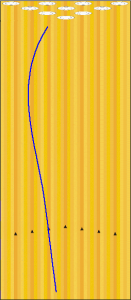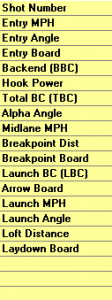See written review and video at Columbia Burst Ball Review
Here is a supplemental review with Digitrax Analysis.
Below, you can see all tracks and the average track as recorded by Ebonite Digitrax. On the left, you can see the statistical analysis.
I am bowling on a medium to medium-light house shot with dry boards outside 5. It’s a pretty steep cliff from wet to dry around the 7 board so I try to target inside the 2nd or 3rd breakzone to stay away from the dry. I have 350-400 revs on any given shot and I average between 220 and 230 in this house.
Let’s evaluate…
I am averaging around 16.5 mph launch speed. This allows the ball to have some traction. I am laying the ball down around the 18 board, targeting the third arrow, out to about 9 at the breakpoint. You’ll notice that the breakpoint is around 44 ft which seems quite far downlane. This is due to a clean cover and playing deeper at the breakpoint on about 41 ft pattern. The tricky part is seeing the midlane read which isn’t as obvious on the digital track. This cover is pretty clean through the heads and comes 4000 grit polished. This cover does not have a lot of teeth, but the core is a smooth, early revving piece. It generates quite a bit of midlane read. This combination allows the ball to be fairly versatile on this type of condition. You will notice that in this sequence of shots, it generates 5 degrees of entry angle. If you’ve read my article on entry angle, I think this is in the ideal range. I’ve intentionally reduced the entry angle by starting deeper and keeping my breakpoint in. The ball reacts very consistent off this spot. With this entry angle, carry is phenomenal. I have been able to generate up to 8.5 degrees of entry angle, going as far wide as 3 at the breakpoint and the ball still carries. It is able to generate varying degrees of entry angle depending on the breakpoint you use. The ball has enough strength to get to the pocket with power, using the room that the house shot gives you.
The biggest asset to this ball is what the core does to the ball reaction. The smoothness of the core/cover creates an uncanny consistency you don’t expect with a mostly pearlized shell. For an early revving core, it still has tons of backend strength. It’s a blend that I haven’t seen in a while from a pearlized ball, although not totally surprising coming from Columbia.
One thing that is not obvious in the digitrax tracks is the continuation this ball has after it enters the pocket. Because of this, the ball likes to be swung if you have 300+ revs. I find that trying to use it more direct causes deeper entry angles and too much continuation leaving all assortments of back row pins. If you are a bowler who gets lower revs or is speed dominant, you may have more luck throwing this ball direct. Because of how the ball reacts off my hand in this particular house, I can not throw it direct so must limit its use to when the deeper shot is available.
Bottom Line
This is an excellent ball if you are looking for a controllable pearl ball. The early revving core gives this ball a nice hook motion midlane while still being impressively angular. It has lots of continuation so you will want to swing it if you have some hand. Otherwise, it drives a bit too hard. Given that, it will also help those who have lower revs by generating earlier revs on its own. Excellent carry. This is a potential control ball, but don’t mistake it for a ball with weak backend.





